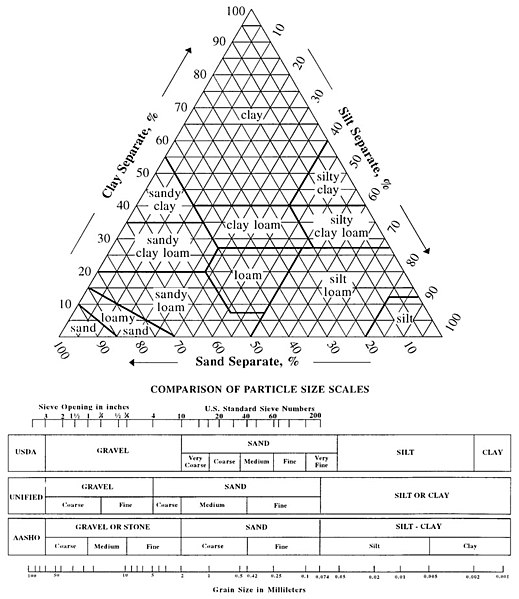博文
土壤(一)质地
||
Soil texture is a soil property used to describe the relative proportion of different grain sizes of mineral particles in a soil. Particles are grouped according to their size into what are called soil separates. These separates are typically named clay, silt, and sand. Soil texture classification is based on the fractions of soil separates present Soil separatesin a soil. The soil texture triangle is a diagram often used to figure out soil textures.
Soil separates
Soil separates are specific ranges of particle sizes. In the United States, the smallest particles are clay particles and are classified by the USDA as having diameters of less than 0.002 mm. The next smallest particles are silt particles and have diameters between 0.002 mm and 0.05 mm. The largest particles are sand particles and are larger than 0.05 mm in diameter. Furthermore, large sand particles can be described as coarse, intermediate as medium, and the smaller as fine. Other countries have their own particle size classifications.
| Name of soil separate | Diameter limits (mm) |
| Clay | less than 0.002 |
| Silt | 0.002–0.05 |
| Very fine sand | 0.05–0.10 |
| Fine sand | 0.10–0.25 |
| Medium sand | 0.25–0.50 |
| Coarse sand | 0.50–1.00 |
| Very coarse sand | 1.00–2.00 |
Soil texture classification
Soil textures are classified by the fractions of each soil separate (sand, silt, and clay) present in a soil. Classifications are typically named for the primary constituent particle size or a combination of the most abundant particles sizes, e.g. "sandy clay" or "silty clay." A fourth term, loam, is used to describe a roughly equal concentration of sand, silt, and clay, and lends to the naming of even more classifications, e.g. "clay loam" or "silt loam."
In the United States, twelve soil texture classifications are defined by the USDA:
- Clay ( 粘土)
- Silt (粉土)
- Sand (砂土)
- Loam (壤土)
- Silty clay
- Sandy clay
- Clay loam
- Silt loam
- Sandy Loam
- Loamy sand
- Silty clay loam
- Sandy clay loam
Determining the soil textures is often aided with the use of a soil texture triangle.
Soil texture triangle, showing the 12 major textural classes, and particle size scales as defined by the USDA.
History of classification
The first classification, the International system, was first proposed by Atterberg (1905), and was based on his studies in southern Sweden. Atterberg chose 20 μm for the upper limit of silt fraction because particles smaller than that size were not visible to the naked eye, the suspension could be coagulated by salts, capillary rise within 24 hours was most rapid in this fraction, and the pores between compacted particles were so small as to prevent the entry of root hairs. Commission One of the International Society of Soil Science (ISSS) recommended its use at the first International Congress of Soil Science in Washington in 1927. Australia adopted this system and according to Marshall (1947) its equal logarithmic intervals are an attractive feature worth maintaining. The USDA adopted its own system in 1938, and the FAO used the USDA system in the FAO-UNESCO world soil map and recommended its use.
References
- Soil Texture, by R. B. Brown, University of Florida, Institute of Food and Agricultural Sciences.
- Atterberg A (1905) Die rationalle Klassifikation der Sande und Kiese. Chemiker Zeitung 29, 195-198.
- Davis ROE, Bennett HH (1927) Grouping of soils on the basis of mechanical analysis. United States Department of Agriculture Departmental Circulation No. 419.
- Marshall TJ (1947) Mechanical composition of soil in relation to field descriptions of texture. Council for Scientific and Industrial Research, Bulletin No. 224, Melbourne.
- Prescott JA, Taylor JK, Marshall TJ (1934) The relationship between the mechanical composition of the soil and the estimate of texture in the field. Transactions of the First Commission of the International Society of Soil Science 1, 143-153.
- Toogood JA (1958) A simplified textural classification diagram. Canadian Journal of Soil Science 38, 54-55.
- Whitney M (1911) The use of soils east of the Great Plains region. United States Department of Agriculture Bureau of Soils Bulletin No. 78.
https://wap.sciencenet.cn/blog-347887-301443.html
上一篇:Sigmaplot的两个实用偏方
下一篇:昨天(2010.4.28)是一个不能遗忘的日子